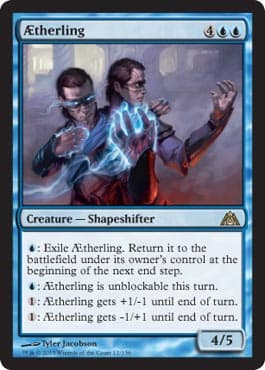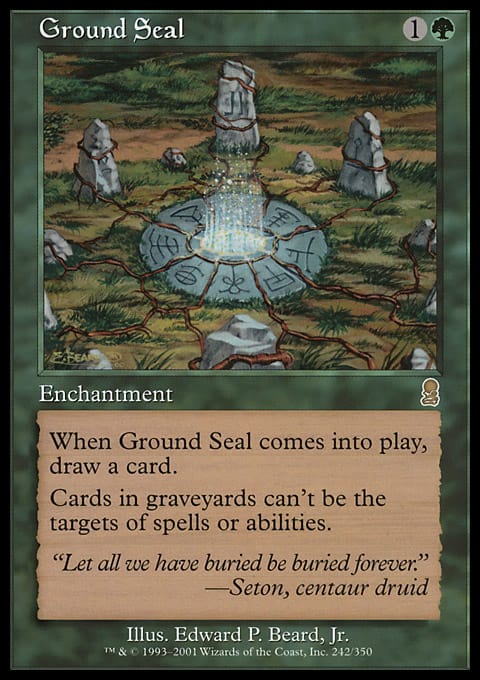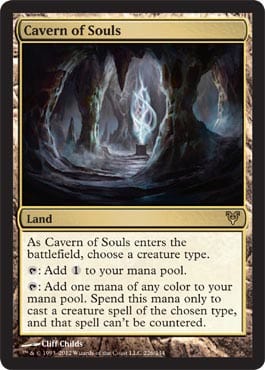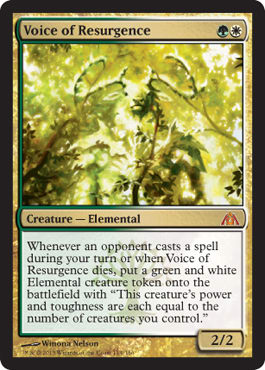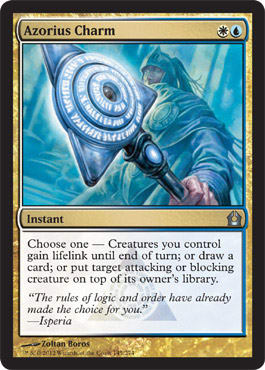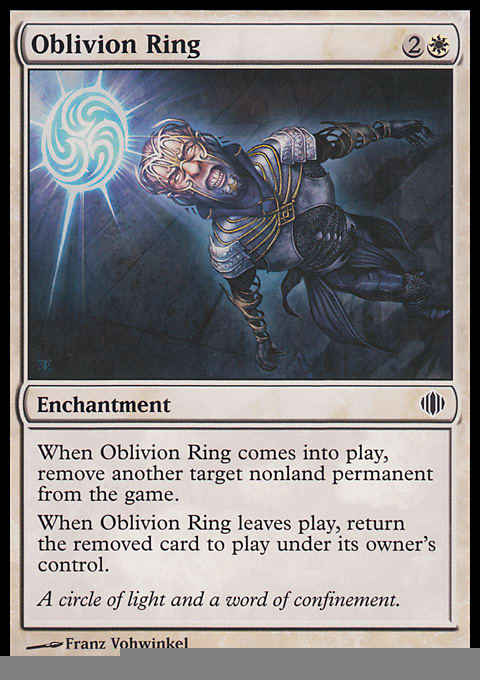Hey, everyone!
I have been busy with school and work, but I still found some time to play my favorite format—Standard. No, seriously, it’s pretty fun.
To the surprise of no one, my weapon of choice is still Bant control. It’s a strange deck in this format because it’s very underrepresented, but it has some strong advocates—and I’m one. Everyone I know who is on board has been for many months.
Since my last article, a lot has changed with my Bant deck. The addition of Dragon’s Maze meant that Standard got a whole new look thanks to Voice of Resurgence. So far, the Magic 2014 spoiler hasn’t provided any additional tools for this archetype, but there are still about a hundred cards remaining. With these two things in mind, I think there’s plenty to gain talking about the current Bant list.
Before I go any further, this is my latest version:
"Bant Control"
- Creatures (10)
- 1 Aetherling
- 2 Augur of Bolas
- 3 Restoration Angel
- 4 Thragtusk
- Spells (25)
- 1 Syncopate
- 2 Dissipate
- 2 Selesnya Charm
- 3 Think Twice
- 4 Azorius Charm
- 4 Sphinx's Revelation
- 4 Farseek
- 4 Supreme Verdict
- 1 Oblivion Ring
- Lands (25)
- 1 Island
- 1 Steam Vents
- 2 Kessig Wolf Run
- 3 Breeding Pool
- 3 Sunpetal Grove
- 3 Temple Garden
- 4 Glacial Fortress
- 4 Hallowed Fountain
- 4 Hinterland Harbor
- Sideboard (15)
- 2 Rhox Faithmender
- 1 Renounce the Guilds
- 3 Terminus
- 2 Ground Seal
- 3 Loxodon Smiter
- 1 Cavern of Souls
- 1 Aetherling
- 2 Negate
Let’s go over some of the key features of the deck:
Aetherling
This card is very helpful against control and midrange decks, but it feels like a mulligan versus aggro. Assuming you’re in a control-heavy metagame, I would suggest adding the second copy (three may not be crazy). I have plenty of time to find Aetherling against other blue decks because of the drawn-out affairs that end up happening. Many opponents don’t bother countering cards such as Think Twice, which allow you to find the single copy more often.
It is also very important against reanimator decks (Junk and four-colored) because Angel of Serenity and Thragtusk clog up the board. Remember that you can pump up Aetherling with Kessig Wolf Run to deal more than 8 damage per turn.
An alternative control strategy is to make a deck with an abundance of anti-aggro spells and three Aetherlings plus Cavern of Souls to ensure a great mirror matchup.
Selesnya Charm and Oblivion Ring
I don’t think there are too many spots to tamper with in this deck, but these removal spells are quite situational. When building a control deck, there are many things to consider:- If you play Renounce the Guilds, play Oblivion Ring over Detention Sphere.
- Make sure you have two to three ways to kill Sire of Insanity at instant speed.
- If you play Augur of Bolas, make sure there aren’t too many enchantment-based removal spells.
- Have an answer to Angel of Serenity if possible. I like Selesnya Charm because Reanimator decks typically just target creatures in their graveyards; it’s possible to exile Angels with the triggers on the stack so they won’t return to the hands. Keep in mind that effect is optional, so a savvy opponent will choose to not use the ability after he or she sees a Selesnya Charm targeting it.
- Does the removal have any other additional synergy in your deck? Selesnya Charm can be versatile because of Kessig Wolf Run pumping a creature to 5 power.
- Renounce the Guilds is a strong consideration and made the cut in the sideboard because it kills Domri Rade, Boros Reckoner, the Aristocrats, Olivia Voldaren, Huntmaster of the Fells, Sire of Insanity, and many more. I didn’t want it in the main deck because all it does against red decks is kill a Burning-Tree Emissary or Rakdos Cackler.
As you can see, I take a lot of different issues into consideration when I choose removal spells. Another key issue is: How many situational kill spells is too many? Oblivion Ring is clearly the most versatile, but comes at a price—it can’t be revealed to Augur of Bolas. It can also die to Abrupt Decay (the only good target in the deck) and is sorcery-speed. I tried many different versions of this deck, and I didn’t want three situational kill spells (Selesnya Charm and Renounce the Guilds) because it contributed to me feeling as though I was flooding out.
I like Selesnya Charm because it can kill early creatures while not being dead in the late game. There have also been games in which it was helpful to make a Knight token when I had a Kessig Wolf Run in play.
I don’t mention Azorius Charm in this space because it is the most versatile removal spell in the Bant colors. The reason I don’t like to play Jund decks is that most of the deck’s removal is useless against control; you can just cycle Azorius Charm if it’s not useful.
Countermagic
Under the right circumstances, I would play a fourth counter in the main deck, but they are embarrassing against aggro. Last time I wrote about this deck, I was all about the second Syncopate, but it has been doing less and less for me. The idea of it doing something on turn two was appealing, but I was often casting Augur of Bolas, Farseek, or a Charm on that turn anyway against aggro.
It’s also important to realize that a savvy opponent will play around your Syncopate, which is an easier feat than Dissipate. I didn’t find too many windows to cast a Syncopate and another spell on the same turn. You may think Syncopate is a hard counter, but the reality is that beggars can’t be choosers, and you have to counter what you can on the turn it’s available.
The Sideboard
Terminus
Even if you don’t pull off the exciting miracle, this is still a great card against plenty of creature decks. The various forms of The Aristocrats aren’t too afraid of Supreme Verdict, so this is a great alternative. Bant Hexproof also presents threats each of which demands an answer but shakes off targeted removal.
Naya Blitz is still being played since it offers the allure of ridiculous Burning-Tree Emissary starts. You might be dead before a Supreme Verdict can be cast, so the miracles can increase the number of games it’s possible to stabilize.
Don’t forget about green decks that pack all-stars such as Strangleroot Geist, Lotleth Troll, and Predator Ooze. Do you think they care about your primary removal spells? Voice of Resurgence is also quite popular, and a Terminus prevents the opponent from creating a token.
The most skilled aggro players will conserve their threats so your single creature-sweeping effect may not be enough. I have difficulty against fast red decks when the opponent stops playing threats after turn two in anticipation of a Supreme Verdict and then play a Hellrider.
Ground Seal
This card is so much better than Rest in Peace for an abundance of reasons. R/W/U control has access to Snapcaster Mage, which is nullified by Ground Seal and you are able to draw a card. The fact that it’s essentially a Meddling Mage naming Snapcaster Mage against opposing control decks means I don’t want to play those decks for myself. I often find Snapcaster Mage is good against the decks I board in Ground Seal against, so there isn’t much of a point to playing it.
A reanimator deck’s main answer to graveyard-hating enchantments is Acidic Slime. Sure, the deck can also have Abrupt Decay, but it’s often not worth it to sideboard in (in my opinion). Why play Rest in Peace when the opponent will either kill it with an uncounterable Abrupt Decay or an Acidic Slime (off Cavern of Souls naming Ooze)? If the opponent kills Ground Seal, you at least were able to draw a card off it.
Card velocity is important against Reanimator because your main plan is to kill with Aetherling. The additional Cavern of Souls provides the thirtieth land source (four Farseeks plus lands) to aggressively ramp up to 7 mana to cast it with a mana left over to blink. Ground Seal is basically a roadblock because you would have to play four of them to actually stop the opponent from using the graveyard, and that isn’t worth it unless it’s more popular in your area. The couple copies of Ground Seal distract the Reanimator opponent from using Acidic Slime to kill what actually matters: lands.
My single red source, Steam Vents, is the only way to activate Kessig Wolf Run. You may think this is a problem because Acidic Slime will just destroy it, but it isn’t too big of an issue after sideboarding. Most Wolf Run Bant decks play a second red source, but I argue it isn’t needed. Would you rather kill a Kessig Wolf Run or a Steam Vents if given the opportunity? I think the Wolf Run is more appealing because a Farseek fetching a second red source is very likely while I have to naturally draw the second Wolf Run.
Even if my single red source dies, I now have Aetherling to pick up the pieces with my extra mana. It doesn’t matter what lands the opponent hits because they are all necessary to pump with Kessig Wolf Run. If I have two lands destroyed with Acidic Slime, i will probably not have enough to effectively pump my creatures while Aetherling can still just hit for 8 points a turn.
I chose to devote so much time into the strategy of playing against Acidic Slime because it’s the most important card in the Reanimator matchup. Be happy when the Reanimator player kills your Ground Seal because Aetherling is your ticket to victory.
Cavern of Souls
If blue decks are popular in your area, Cavern is the correct choice in this slot. If you want to have your Kessig Wolf Run activate against Reanimator, this could be replaced by a sideboarded Steam Vents. I stick with Cavern of Souls because casting an uncounterable Aetherling against control is more important than activating Kessig Wolf Run against Reanimator.
Rhox Faithmender
There are those who are for and against this card in the sideboard. Even though it is bad when your plan is to kill a bunch of creatures with Supreme Verdict, I still think it’s strong enough against red decks to warrant the inclusion. Other options include Centaur Healer and Righteous Blow, but they don’t pack enough of a punch. The Centaur Healer addition would also conflict with Loxodon Smiter, which is not only good versus red, but also against control decks. Righteous Blow is gaining some steam as an aggro foil, but it’s very awkward against Ghor-Clan Rampager.
Cards That Didn’t Make the Cut
Advent of the Wurm
When Dragon’s Maze was initially released, I was a big fan of Advent of the Wurm in Bant control, but now I am less excited about it. There aren’t too many options when it comes to flashy fatties, but I think Restoration Angel is all you need. It was nice to reveal with Augur of Bolas, but it often wasn’t too helpful when I had it.
Playing Advent of the Wurm in a deck like this is committing a common error in control deck-building. The reason to play a control deck is to fight on a linear axis that is not the traditional beatdown strategy. You have an edge playing control decks because the removal spells are less than stellar against Thragtusk, Augur of Bolas, and Aetherling. Kessig Wolf Run ensures you will close out a game if it goes long, so why bother trying to kill with a random 5/5? I often think it’s a mistake to attack against the red decks because haste creatures out of nowhere are the only way to lose when you’re in control. The opponent will typically concede eventually, so you may as well just build up a giant army of monsters.
When you’re playing a game, ask yourself if you will counter the opponent’s removal spell on your Wurm token. I never bothered trying because the opponent probably has another kill spell after he or she takes 5 damage. Is there even a big difference between 10 and 15 life for your opponent? I would argue that it doesn’t matter in most cases because your plan is to win the long game.
Restoration Angel is the superior blocker because a token is much more vulnerable and because you can blink out Thragtusk and Augur of Bolas. In addition, the creatures are so big that the trample won’t completely take out a planeswalker in one hit. Restoration Angel’s evasion will take two hits, but there are fewer flyers to block.
Loxodon Smiter comes in frequently, but I argue it’s weak in the main deck because opposing removal spells will have a good target in Game 1. It adds an extra element of offense that makes your deck more dynamic; does your opponent leave in removal because you may board in a creature? It’s not an easy question to answer.
Voice of Resurgence
I’m glad I don’t like this card in Bant control because it’s very expensive. Loxodon Smiter is better in the sideboard because it hits harder and can be discarded against Liliana of the Veil to make for a blowout against Jund.
Voice also lacks the versatility of Loxodon Smiter out of the sideboard because I want the 4/4 body against red decks (without Rancor). When a deck with a small number of creatures plays Voice, the token that is left behind is rarely larger than a 2/2, which isn’t very impressive. Don’t get me wrong; Voice of Resurgence is a great card, but it’s still just a hate bear, and it’s not for every G/W deck.
Plasm Capture
This feels like more of a sideboard card to me because it makes counters look even worse against aggro. The
A cool/awkward trick with Plasm Capture is to counter a spell that is uncounterable with Cavern of Souls. Although the spell will still resolve, you can still generate the mana because your spell still resolves also. It will rarely come up, but it will be exciting when it does. I had to make a similar play that involved Rewinding a hellbent Demonfire in order to untap an Azorius Chancery. This trick also works with Remand to draw a card.
Sideboarding
Blue Mirrors
Loxodon Smiter comes in because you have fewer counters for the mirror. It’s important to be offensive when you can. Against R/W/U control, I like to save Restoration Angel to protect the Smiter because the opponent’s best kill spell is Warleader's Helix.
Negate, Cavern of Souls, and Aetherling come in so you can play the traditional post-board control mirror. In general, it’s correct to name Shapeshifter with your Cavern because Aetherling is the most important card.
I like to board out a combination of removal spells, but I prefer to keep Azorius Charms if possible because it cycles. When both players have an Aetherling in play, Azorius Charm is among the few ways to pull ahead in the race.
Reanimator
Ground Seals, Cavern of Souls, and Aetherling come in because your game plan is to win with the unblockable Aetherling. Selesnya Charm is nice here because it kills the opponent’s sideboarded Obzedat, Ghost Council while also stopping the annoying Angel of Serenity. Azorius Charm isn’t amazing here, but I still like a couple copies because it puts Obzedat on top of the deck or can cycle for a card. I would rather not Azorius Charm an Acidic Slime, Angel of Serenity, or Thragtusk.
I board out an Azorius Charm, two Supreme Verdicts, and Oblivion Ring. The issue with enchantment-based removal is evident after the opponent blows up your Ring to return a threat with Acidic Slime.
I used to like Negate against Reanimator, but I’m not as impressed now. Mulch will hit a single land on average because there are a maximum of twenty-four lands in the deck, so it’s not a big deal to counter it. You can’t sit around with counters for too long because the opponent has a great endgame in Angel of Serenity.
I don’t want Renounce the Guilds against Junk or four-colored Reanimator because Sin Collector makes it awkward. It’s rare to actually mess up the opponent’s plans by playing Renounce to hit a Boros Reckoner because he or she can recur it with Unburial Rites.
Jund Midrange
Loxodon Smiter can pressure a Liliana of the Veil, but beware that it can be possibly invalidated thanks to Thragtusk. Slaughter Games is less of a threat now that the opponent has to worry about Thragtusk, Sphinx's Revelation, and Aetherling.
These matchups are more grindy than the blue mirrors, so I’m less worried about making each land drop; hence, I don’t bring in Cavern of Souls.
Renounce the Guilds is effective against Jund because it kills Huntmaster of the Fells, Sire of Insanity, and Olivia Voldaren. Negate is good because Garruk, Primal Hunter is the other primary threat. Be careful about tapping out for a Thragtusk on turn five because you can wait until you have 7 mana to leave up Negate or Selesnya Charm for the biggest threats. Don’t worry about being too aggressive because Thragtusk will typically reduce the games to a halt.
Remember to use Restoration Angel and Think Twice at strategic times to mess with the transforming of Huntmaster of the Fells. Also consider the fact that the last land the opponent plays will be Cavern of Souls on Demon to make Sire of Insanity uncounterable. It can be a tell if that’s his or her land for the turn because a Jund player doesn’t want you to know his or her best card can’t be countered.
Oblivion Ring is awkward if the Jund opponent leaves in Abrupt Decay. This is a judgment call because the opponent may reconsider once he or she sees Loxodon Smiter, so there’s no formula.
Azorius Charm is once again in a strange place because you don’t want the opponent to draw his or her creatures again next turn, but it also cycles in the early turns. Supreme Verdict is good because Huntmaster is good against your countermagic and Sphinx's Revelation. If you tap out to Revelation to stop Huntmaster from transforming, you run the risk of being blown out by Sire of Insanity.
Aggro
There are many forms of aggro, including mono-red, R/G, Naya Blitz, and Domri Naya. The main premise is to stay alive by using Azorius Charm aggressively. Although many players think Skullcrack is good against Bant, the real issue for me is Domri Rade and early threats.
Against Naya Blitz and Domri Naya, Terminus is essential to avoid annoying tokens from Voice of Resurgence. Loxodon Smiter is better versus base-red aggro decks because I don’t want Terminus or Renounce the Guilds against them. I need Renounce the Guilds against the Naya decks to kill Domri Rade and Voice.
Although I run the risk of killing my Rhox Faithmender with Terminus, it’s still quite good against all of the red aggro decks. You can take home a game easily with a Thragtusk that gains 10 life. I don’t like blocking with it the turn it comes into play because of Ghor-Clan Rampager, but the following turn leaves the opponent vulnerable to either one of your Charms.
The counterspells are very weak in these matchups because you tap out early for Charms, Rhox Faithmender, Supreme Verdict, and Loxodon Smiter. The Aetherling also comes out because it’s so low. In most cases, the game going long favors you, and weaker cards are capable of going over the top (Thragtusk and Restoration Angel).
The Aristocrats
Both of these decks have a critical 4-drop you need to worry about; Junk has Sorin, Lord of Innistrad, and Act 2 has Falkenrath Aristocrat. Key sideboard cards include Terminus to kill Falkenrath Aristocrat, Doomed Traveler, Voice of Resurgence, Varolz, the Scar-Striped, and Blood Artist and Renounce the Guilds for the many multicolored threats. Your counterspells are awkward because a timely Cavern of Souls is difficult to predict. It’s nice that a Syncopate or Dissipate gets rid of Lingering Souls and the opponent can’t make Sorin uncounterable.
I don’t want Loxodon Smiter against either version of the deck because your four sideboard cards all kill it (Terminus and Renounce). It also doesn’t do so hot in a fight with Spirit tokens or a giant Demon token.
I wouldn’t mind cutting a copy of Supreme Verdict because a lot of the creatures still stay in play. Selesnya Charm can randomly kill either Aristocrat or Obzedat. Remember the Sorin emblem can also be harmful to the opponent’s creatures, as it can put them over 4 power for your Charm.
Well, this article went pretty long, so I’ll wrap it up here. I am a big supporter of Wolf Run Bant, and I encourage you to try it. Even if it’s not your cup of tea, I hope it gave you some insight on how to fight it. Feel free to comment on ideas to improve the deck as it is always a work in process.
Thanks for reading,
Kyle













